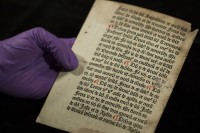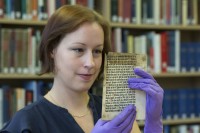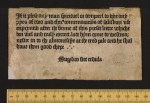 A two-sided page from a 15th century priest handbook printed by William Caxton has been discovered in archives of the University of Reading. Written in Medieval Latin, the leaf was part of a book called the Sarum Ordinal or Sarum Pye, a manual for priests on managing feast days for English saints during the ecclesiastical year. It was printed by William Caxton in his shop, the Red Pale, in late 1476 or early 1477 and was one of the first books printed in England. The University of Oxford’s Bodleian Library has a notice from Caxton’s shop promoting the manual which is the earliest surviving printed advertisement in English publishing history.
A two-sided page from a 15th century priest handbook printed by William Caxton has been discovered in archives of the University of Reading. Written in Medieval Latin, the leaf was part of a book called the Sarum Ordinal or Sarum Pye, a manual for priests on managing feast days for English saints during the ecclesiastical year. It was printed by William Caxton in his shop, the Red Pale, in late 1476 or early 1477 and was one of the first books printed in England. The University of Oxford’s Bodleian Library has a notice from Caxton’s shop promoting the manual which is the earliest surviving printed advertisement in English publishing history.
One of only two known surviving fragments from this enormously significant edition in the history of English publishing, the leaf is in very good condition even though it hasn’t exactly been treated with kid gloves over the years. For three centuries it was glued into the spine of another book to reinforce the binding. It was saved from that ignominy by a University of Cambridge librarian in 1820 who put it in a scrapbook along with other fragments rescued from bindings, but not even he recognized it as an original Caxton page.
 University of Reading Special Collections librarian Erika Delbecque, on the other hand, knew right away she had struck gold.
University of Reading Special Collections librarian Erika Delbecque, on the other hand, knew right away she had struck gold.
“I suspected it was special as soon as I saw it. The trademark blackletter typeface, layout and red paragraph marks indicate it is very early western European printing. It is incredibly rare to find an unknown Caxton leaf, and astonishing that it has been under our noses for so long.”
The pages are part of the John and Griselda Lewis Collection. John Lewis was a typographer and pioneering scholar in the field of printed ephemera. Griselda was a writer. Between them, they amassed a collection of more than 20,000 items pertaining to the history of printing. The University bought the John Lewis Printing Collection at auction in 1997 for £70,000 ($90,000), with the aid of a £60,000 grant from the Heritage Lottery Fund. The collection is stored in 87 boxes at the University of Reading’s Centre for Ephemera Studies in the Department of Typography & Graphic Communication.
The collection is still in the process of being catalogued, which is what Erika Delbecque was doing when she came across the Caxton leaf.
Copies of the Sarum Ordinal were produced in Westminster, before the Reformation, and consisted of around 160 leaves. The text was originally established as a manuscript by St Osmund, the Bishop of Salisbury, in the 11th century. It would have been owned by clergymen and consulted on a regular basis, but was discarded after the Reformation.
Only one other surviving fragment of the book exists, consisting of eight double-sided leaves, which are held at the British Library in London.
 The University of Reading’s leaf is from a different part of the book than the British Library’s pages, so it is unique.
The University of Reading’s leaf is from a different part of the book than the British Library’s pages, so it is unique.
The Caxton leaf is on display at the University’s Special Collections department at the Museum of English Rural Life on London Road through the end of the month. Admission is free.
This is horribly depressing. Today is my Birthday and I am looking at this rare printing, amazed it was discovered by such a ‘sharp eye.’ THEN, I take note of the photo of the University of Reading Special Collections librarian, Erika Delbecque. She’s so very, very young to be this wise – not a furrow to her sweet brow nor aged frosting to her coif! Now, I’m feeling even more ancient myself… Heck, I might have seen this printing when it was new.
Those Manuals for priests on managing feast days during the ecclesiastical year must have been sheer rocket science. Mainly, because there was no proper ecclesiastical year in the first place, the Latin mediocre and the environment harsh:
————
[@Audrey BIRTHDAY PRESENT :hattip: ] English Translation of the 1493 ‘Nuremberg Chronicle‘ – FOLIO CCLXXXVIIII
In ENGLAND, King Henry, a man addicted to retirement and idleness, ruled the kingdom on foreign advice rather than by the exercise of his own judgment. The duke of Suffolk was mighty and powerful with the king during this time, for he governed the common people as well as the nobility according to his own will. But when English influence in France declined, and French power became re-established, the duke of York, with no small number of men, as well as nobles, came to London with the intention of effecting a change in the king’s council, and improving the status of the king and queen. But Suffolk did not tarry to await the consequences. He took to sea and fled from thence. But who can escape his fore-ordained death; for a number were ordered to hastily pursue him, and he was arrested and slain. The duke of Somerset who returned to England after the loss of Normandy was also mighty and powerful with the king; but he was imprisoned and many of the nobility were slain. A number of the clergy were not spared either, among them our friend Adam Molynes [Adam Moleyns, Bishop of Chichester], secretary to the king, who was beheaded. Not long thereafter, when the duke of York returned home, the duke of Somerset, who had now been liberated with the consent of the king, began to govern the kingdom; this brought him to great grief, for he was slain by the duke of York.
In Engelland hat koenig Heinrich der ainoedigkeit vnd muessigkeit ein giriger man mer auß frembder denn aigner maynung das koenigreich geregirt. Hertzog Sopholti was zumal mechtig vnd gewaltig bey disem koenig dannn er regiret das gemain volck vnd auch den adel nach seinem willen. als aber die Engellendisch sach bey den frantzosen gemyndert wardt vnd der frantzosisch gewalt sich zeforigem stand auffrichtet do kam der Eboracensisch hertzog nicht mit klainem volck. auch nicht mit wenig adels gein Lundon in willen des koenigs rat zewandeln vnnd den stand des koenigs vnd des coenigreichs in besser wesen zebringen. aber Sopfulti wolt seiner zukunft nit erharren sunder er setzet sich eylend auff ein schiff vnd flohe von dannen. aber wer kan seinem gesetzten todt empfliehen. denn ettlich warden ime nachzeeylen gesand die ergriffen ine todschlahend. Der hertzog Somerseti der nach verlorner Normannia wider gein Engelland keret was auch mechtig vnd gewaltig bey dem koenig aber wardt gefangen vnd vil adels getoedt vnd auch der briesterschaft nit verschonet. vnd vnder denselben vnser freuend Adam molynes des koenigs secretari enthawbtet. Vnlang darnach als der Eboracensisch hertzog wider anhayms komen was do begunde Somerseti der fuerst auß gefengknus gelassen mit verhengknus des koenigs das koenigreich zeregirn. das kome im zu grossem toedtlichen schaden dann er wardt von dem Eboricensischen hertzog erschlagen.
Here the advertisement (as a non-native speaker, I was having some difficulties – whicheten? :confused: )
—————-
If it pleases any man spiritual or temporal to buy any Pyes of two and three commemorations of salisbury use printed after the form of this preset letter whicheten[?] well and truly correct, let him come to Westminster into the almonry at the reed pale and he shall have them good cheap.. Supplico stet cedula [I please, it should stay displayed]
Ah, Audrey, but you would at least have arranged your necklace properly.
Anyway, full marks to young Erika.
P.S. Am I alone in grinning at “University of Reading’s Centre for Ephemera Studies in the Department of Typography & Graphic Communication”?
And that too shall pass away.
“…which (have) been well and truly …” ???
Truly Yours, Wolgemut.
—–
PS: It will ALL pass away, 😮 in Reading and in Wrydinge.
Except, and here is the Good News! II Corinthians 5:17 “Therefore, if anyone is in Christ, he is a new creation; old things have passed away; behold, all things have become new.”